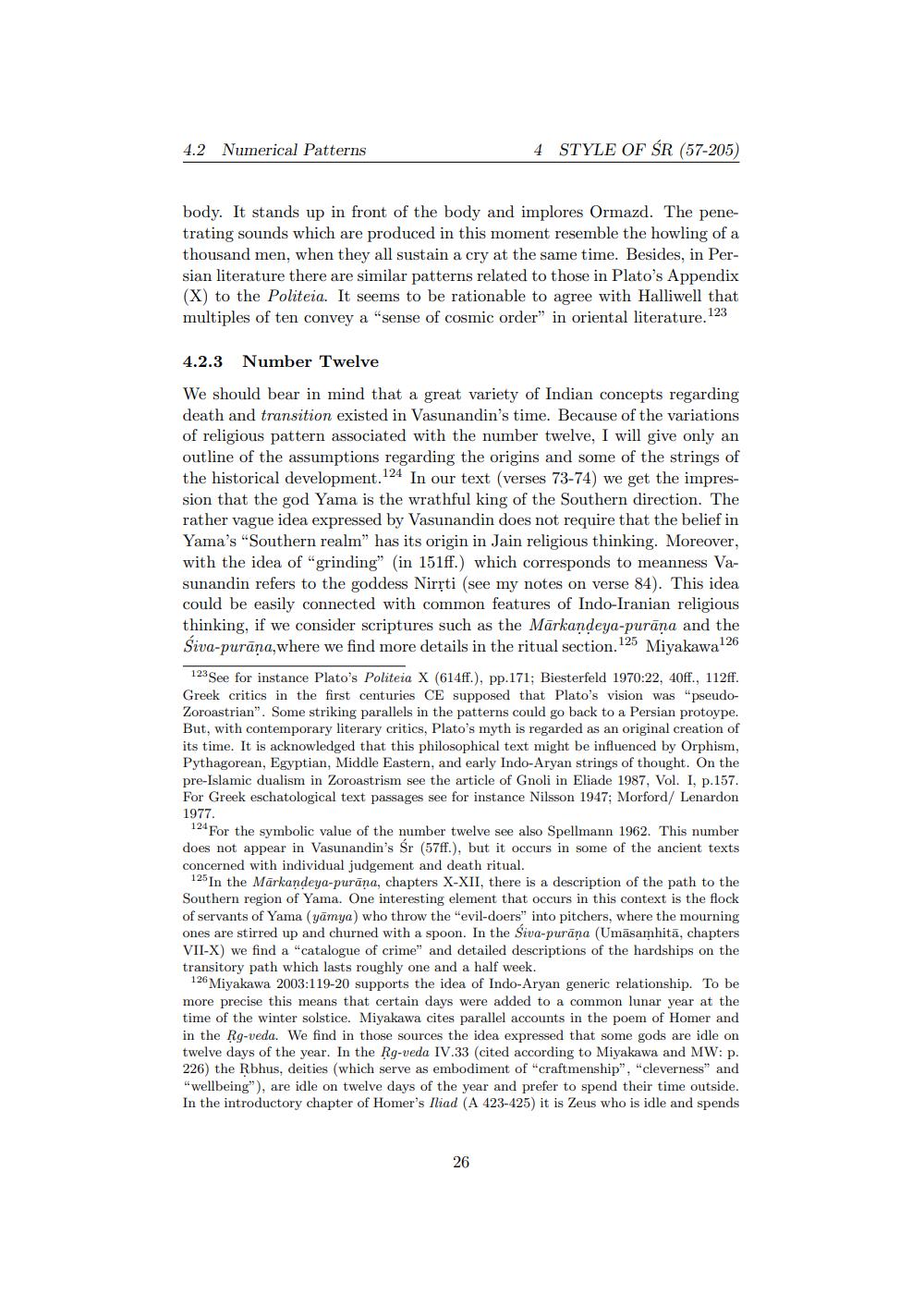________________
4.2 Numerical Patterns
4 STYLE OF ŚR (57-205)
body. It stands up in front of the body and implores Ormazd. The penetrating sounds which are produced in this moment resemble the howling of a thousand men, when they all sustain a cry at the same time. Besides, in Persian literature there are similar patterns related to those in Plato's Appendix (X) to the Politeia. It seems to be rationable to agree with Halliwell that multiples of ten convey a "sense of cosmic order" in oriental literature."
123
4.2.3 Number Twelve
We should bear in mind that a great variety of Indian concepts regarding death and transition existed in Vasunandin's time. Because of the variations of religious pattern associated with the number twelve, I will give only an outline of the assumptions regarding the origins and some of the strings of the historical development. 124 In our text (verses 73-74) we get the impression that the god Yama is the wrathful king of the Southern direction. The rather vague idea expressed by Vasunandin does not require that the belief in Yama's "Southern realm" has its origin in Jain religious thinking. Moreover, with the idea of "grinding" (in 151ff.) which corresponds to meanness Vasunandin refers to the goddess Nirṛti (see my notes on verse 84). This idea could be easily connected with common features of Indo-Iranian religious thinking, if we consider scriptures such as the Märkandeya-purana and the Śiva-purana, where we find more details in the ritual section. 125 Miyakawa 126
123 See for instance Plato's Politeia X (614ff.), pp.171; Biesterfeld 1970:22, 40ff., 112ff. Greek critics in the first centuries CE supposed that Plato's vision was "pseudoZoroastrian". Some striking parallels in the patterns could go back to a Persian protoype. But, with contemporary literary critics, Plato's myth is regarded as an original creation of its time. It is acknowledged that this philosophical text might be influenced by Orphism, Pythagorean, Egyptian, Middle Eastern, and early Indo-Aryan strings of thought. On the pre-Islamic dualism in Zoroastrism see the article of Gnoli in Eliade 1987, Vol. I, p.157. For Greek eschatological text passages see for instance Nilsson 1947; Morford/ Lenardon 1977.
124 For the symbolic value of the number twelve see also Spellmann 1962. This number does not appear in Vasunandin's Śr (57ff.), but it occurs in some of the ancient texts concerned with individual judgement and death ritual.
125 In the Markandeya-purana, chapters X-XII, there is a description of the path to the Southern region of Yama. One interesting element that occurs in this context is the flock of servants of Yama (yamya) who throw the "evil-doers" into pitchers, where the mourning ones are stirred up and churned with a spoon. In the Siva-purana (Umasamhita, chapters VII-X) we find a "catalogue of crime" and detailed descriptions of the hardships on the transitory path which lasts roughly one and a half week.
126 Miyakawa 2003:119-20 supports the idea of Indo-Aryan generic relationship. To be more precise this means that certain days were added to a common lunar year at the time of the winter solstice. Miyakawa cites parallel accounts in the poem of Homer and in the Ṛg-veda. We find in those sources the idea expressed that some gods are idle on twelve days of the year. In the Rg-veda IV.33 (cited according to Miyakawa and MW: p. 226) the Ṛbhus, deities (which serve as embodiment of "craftmenship", "cleverness" and "wellbeing"), are idle on twelve days of the year and prefer to spend their time outside. In the introductory chapter of Homer's Iliad (A 423-425) it is Zeus who is idle and spends
26




